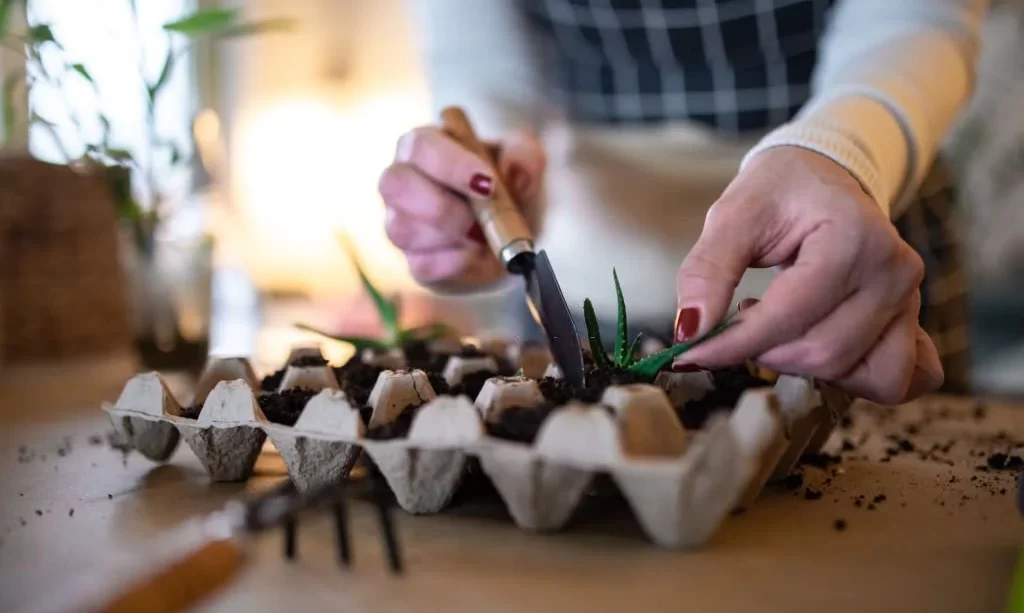Succulents, with their captivating shapes and vibrant colors, have become beloved additions to homes and gardens around the world. These hardy plants are known for their ability to thrive in arid conditions and are celebrated for their low-maintenance appeal. If you’ve ever wanted to expand your succulent collection or nurture your very own succulent from its infancy, you’re in for a rewarding adventure. In this article, we’ll guide you through the process of growing succulents from seeds, a cost-effective and fulfilling way to cultivate these remarkable plants.
- [ Planting method ] Sprinkle the seeds over the soil, cover them with a 1/8-inch layer of fine sand or crushed rock, Try to keep the soil moist throughout the germination period, Cover the pot with plastic wrap or a glass pane to help promote soil moisture retention.
- [ Fertilization ] Be careful not to use a fertilizer that is too strong as it can burn your succulents.
- [ Easy to grow ] Sew in succulent soil and water sparingly.
- [ Packaging ] Interesting shape and color, lots of species and varieties mixed, the package have all seeds mixed not individual labeled.
- [ Grow or gift ] Great gift for mom, dad, gardener.
Gathering Supplies
Before you embark on your succulent-growing journey, it’s crucial to gather the necessary supplies to set the stage for success. Here’s a list of essential items you’ll need:
- Succulent Seeds: Choose a variety of succulent seeds that capture your interest. You can purchase them from reputable suppliers or collect them from existing succulent plants.
- Pots or Trays: Select small pots or seed trays with drainage holes to provide a suitable environment for your succulent seeds.
- Succulent Soil Mix: Invest in a well-draining succulent soil mix or create your own by combining regular potting soil with perlite or sand.
- Labels: Labeling your pots or trays with the names of the succulent species you’re growing will help you keep track of their progress.
- Misting Bottle: A misting bottle or spray can be handy for gentle watering, preventing over-saturation.
- Transparent Plastic Wrap or Dome: These can create a mini greenhouse effect to maintain humidity during germination.
- Growing Lights (Optional): If you’re growing succulents in a location with limited sunlight, consider using grow lights to provide the necessary illumination.
Now that you have your supplies ready, you’re well-prepared to begin your journey into the fascinating world of growing succulents from seeds.
- Formulated to loosen clay and reduce caking
- Improves drainage and aeration
- Available in an 18qt size
Seed Selection
The first step in growing succulents from seeds is selecting the right seeds. Here’s how to go about it:
- Purchase Quality Seeds: Seek out reputable suppliers or nurseries that offer a wide selection of succulent seeds. Look for fresh, viable seeds to increase your chances of successful germination.
- Variety and Species: Succulents come in various species and varieties, each with its unique charm. Choose seeds based on the types of succulents you want to grow, whether it’s the iconic Echeveria, the resilient Sedum, or other captivating species.
- Collecting Seeds: If you’re collecting seeds from your existing succulents, allow the seed pods to fully mature and dry on the plant. Carefully collect the seeds and store them in a cool, dry place until you’re ready to sow them.
- Succulent Seeds Mix – 50 Seeds – Echeveria Species Mix for planting
- Succulent seeds are tiny and some are microscopic. Surface sew and mist with water, Succulents love heat and grow in the desert. 80 degrees plus is optimal for germination.
- CZ GRAIN Satisfaction Guaranteed.
Preparing the Growing Environment
Creating the ideal environment for your succulent seeds is crucial for successful germination. Here’s how to prepare it:
- Temperature: Most succulent seeds require warm temperatures to germinate. Aim for a consistent temperature between 70°F to 80°F (21°C to 27°C) during the day and a slight drop at night.
- Light: While succulent seeds don’t need intense light initially, they do require indirect sunlight or artificial light to grow. Consider using a greenhouse or grow lights to provide adequate illumination.
- Humidity: Succulent seeds benefit from higher humidity levels during germination. You can achieve this by covering your pots or trays with transparent plastic wrap or a dome to create a mini greenhouse effect.
- Ventilation: Proper airflow is essential to prevent mold and fungal issues. Periodically lift the plastic wrap or dome to allow fresh air to circulate.
- Soil Preparation: Fill your pots or trays with a well-draining succulent soil mix. This mix typically includes components like perlite, sand, and regular potting soil. Ensure that the soil is thoroughly moistened before sowing the seeds.
By selecting the right seeds and creating the optimal growing environment, you’ll set the stage for healthy succulent seedlings ready to embark on their growth journey.
Sowing the Seeds
With your selected seeds and prepared environment, it’s time to sow your succulent seeds. Here’s a step-by-step guide to this critical phase:
- Fill Containers: Fill your chosen pots or trays with the prepared succulent soil mix, leaving about half an inch (1.3 cm) of space at the top.
- Spacing: Distribute the seeds evenly over the soil surface. Depending on the species, you may space them apart slightly to avoid overcrowding as they grow.
- Cover Lightly: Gently press the seeds into the soil or cover them lightly with a thin layer of fine-grained sand. This helps ensure good seed-to-soil contact for successful germination.
- Label Pots: Don’t forget to label each pot or tray with the name of the succulent species you’re growing. This will prevent any mix-ups as they start to sprout.
- Instantly feeds succulent plants, including cacti
- For all cacti, jade, aloe and other popular succulents
- Feeds instantly
- Able to apply directly to the soil or can mix with water
- Feed every 2 weeks
Watering and Maintenance
Watering and maintaining the correct moisture level is vital during the early stages of succulent seed growth. Here’s what you need to know:
- Misting or Bottom Watering: Use a misting bottle or a bottom watering method to provide moisture without disturbing the seeds. Avoid soaking the soil; instead, keep it slightly damp.
- Humidity Control: If you’re using a plastic wrap or dome to create a greenhouse effect, check the humidity levels regularly. Ensure that condensation forms on the inside, indicating the right humidity.
- Temperature Consistency: Maintain a stable temperature within the specified range, ensuring that it doesn’t fluctuate dramatically between day and night.
- Ventilation: As the seeds start to germinate and grow, it’s essential to provide adequate ventilation by partially opening the plastic wrap or dome. This prevents excess humidity buildup and encourages healthy seedling development.
Consistent care and attention to these watering and maintenance practices will nurture your succulent seeds through their crucial early stages of growth.
Germination and Growth
As your succulent seeds begin to germinate and grow, there are key milestones to watch for:
- Germination Time: Succulent seeds can take anywhere from a few days to several weeks to germinate. Be patient and keep an eye out for the first tiny green sprouts.
- Seedling Care: Once seedlings appear, provide them with indirect sunlight or gentle artificial light. Maintain the temperature and humidity levels and ensure proper ventilation.
- Thinning: As your seedlings grow, you may need to thin them out, especially if they are too crowded. Carefully remove and transplant excess seedlings to create adequate spacing.
- 🍀Huge Value Package – 18 Pack white succulent planter pots with 18 Pcs Plant Label, the succulent pots with drainage,H2.75″x W2.75″ inch,perfect for holding succulent, herbs and cactus plants,small plants and flowers, great for display.
- 🍀Unique Design – The plant pots indoor are designed with white, The brief stripes bringing out a unique minimalist look,Perfect decoration for office, kitchen, store front, living room and bathroom.
- 🍀Perfect Planters for Succulents: The top has adequate drainage and the bottom will collect the overflow.With Drainage Hole,allows water to flow through the soil to keep your plants grow and breath in health and safe
- 🍀High Quality: Made of sturdy plastic, lightweight and reusable,mold free growing! Unbreakable succulent pots bulk!
- 🍀Package List – You will get set of 18 pots for succulent,and 18 Pcs Plant Label, the approximate size of the pot: 2.75 inch in diameter, 2.75 inch in height; Label size:2.75 inch in height, 1.97 inch in width. *** Plants are not included ***
Caring for Mature Succulents
As your succulent seedlings mature into more established plants, their care requirements change:
- Sunlight: Gradually introduce them to more direct sunlight, depending on the species. Most succulents thrive in bright, indirect light or full sun.
- Watering: Adjust your watering frequency based on the specific needs of your succulent species. Generally, allow the soil to dry out between waterings, and water thoroughly when needed.
- Potting Up: As your succulents outgrow their initial containers, transplant them into slightly larger pots with well-draining soil.
- Fertilizing: Feed your mature succulents with a diluted, balanced succulent fertilizer during the growing season (spring and summer) to provide essential nutrients.
- Pruning and Maintenance: Regularly inspect your mature succulents for any dead or damaged leaves and remove them. This promotes overall plant health.
With proper care and attention, your succulent seeds will grow into mature plants, showcasing the unique beauty and resilience that make succulents a favorite among plant enthusiasts.
Patience and Observation
Growing succulents from seeds is a rewarding journey, but it’s essential to embrace patience and keen observation throughout the process:
- Patience: Succulent growth, especially from seeds, is not a rapid process. It may take weeks, even months, to see significant progress. Resist the urge to rush and let nature take its course.
- Observation: Regularly observe your succulent seedlings and mature plants. Look for signs of health, including vibrant foliage and steady growth. If you notice any issues like overwatering, pests, or diseases, address them promptly.
Conclusion
Growing succulents from seeds is a delightful and budget-friendly way to cultivate a unique collection of these charming plants. By gathering the right supplies, selecting quality seeds, creating an optimal growing environment, and providing proper care, you can nurture your succulent seeds from tiny beginnings to beautiful, mature plants. Remember that the journey of succulent cultivation requires patience, but the rewards of watching your tiny seeds grow into thriving succulents are well worth the wait. Enjoy the process, and let the enchanting world of succulents inspire your green thumb.









